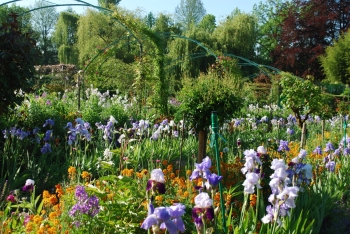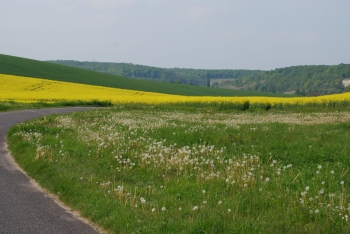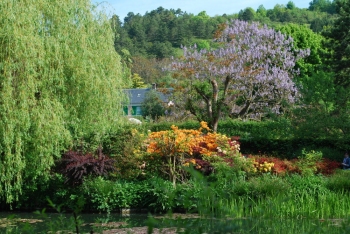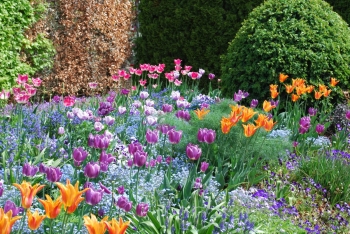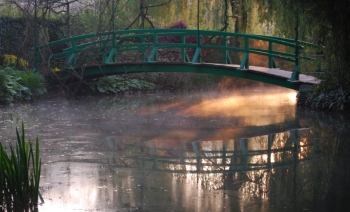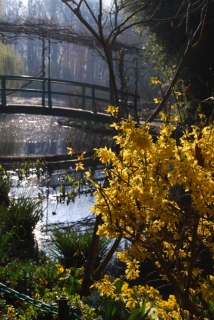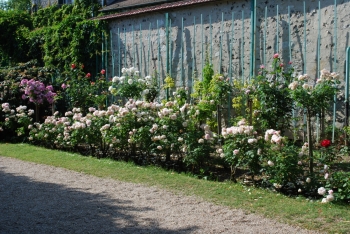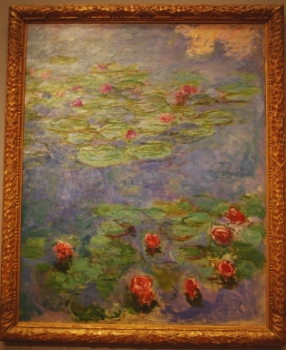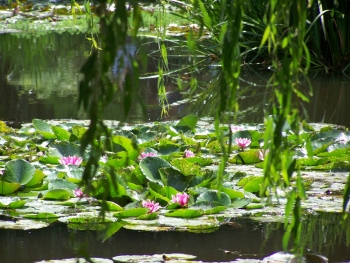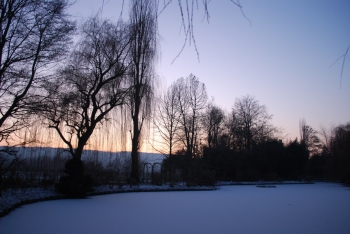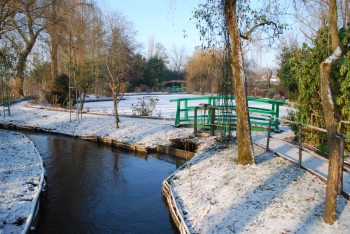June 3, 2010
Monet’s garden at Giverny is so beautiful at the turn of May and June that it has a taste of Paradise.
In this season, spectacular flowers like irises, paeonies, wallflowers and roses bloom all at the same time.
The small walks of the garden disappear, leaving the illusion of a divine meadow adornated by the most exquisite flowers.
Not to speak about the delicate scent floating in the air…
Posted in Giverny, Claude Monet, Monet's flower garden No Comments »
May 22, 2010
Every year in May, the yellow fields scattered all around in the countryside of Normandy intrigue visitors.
– What are they? they keep asking, struck by the vibrant color. No other crop induces so many questions.
– Rapeseed fields, I answer, trying to speak as distinctly as possible.
When visitors of Giverny come from a region of the world where rapeseed is unknown, they frown. They don’t want to believe that this is the real name of the plant. I must be wrong. They ask me to repeat.
I explain all what is done with rapeseed, oil, the green gasoline we call diester, and food for the cattle. I would so much prefer to answer, well, it is mustard for the french fries, you know! I long for next month, when the rapeseed will be blown, and the flax in blossom.
– What are the pale blue fields? people will ask, and they will be only too happy to see where their linen come from.
Posted in Flower No Comments »
May 20, 2010
The beautiful lavender blossom of the paulownia in Monet’s flower garden at Giverny harmonizes with the orange azaleas of the water garden, on the other side of the road.
The paulownia blooms exactly at the same time than the lavender wisterias gracing Monet’s Japanese footbridge.
Is it intended or not? What is a coincidence, and what is due to the choices of a clever gardener?
In Monet’s garden, I believe most of the meetings between plants aren’t accidental. Monet, as well as the present day head gardener, was very good at organising dates among the flowers.
Posted in Giverny, Monet's flower garden, Water-Garden 2 Comments »
May 7, 2010
American visitors to Giverny often ask to which agricultural zone Giverny belongs. A puzzling question indeed, as these zones aren’t commonly used in France!
Asking about the coldest temperature in Winter doesn’t help a lot, because the Frenchs count in Celsius, not in Farenheit.
I finally found the answer: Giverny is in zone 8.
During the coldest night of the last Winter, temperatures reached -13°C, that is to say 8°F. This is OK for many plants, trees and bushes, except the most fragile.
Some flowers even need frost to understand that it is Winter, and then Spring. If tulips, for instance, don’t get all the cold they need, they will sulk and refuse to bloom the next Spring!
Posted in Flower, Impressionism Museum No Comments »
May 1, 2010
Early in the morning, long before the first visitor arrives in Monet’s garden at Giverny, rays of orange sunshine stroke the Japanese bridge of the water garden, while a light mist raises from the pond.
Monet, who was an early bird, loved to get up before sunrise, in order not to miss a second of the dramatic show of light and water.
Posted in Giverny, Claude Monet, Water-Garden No Comments »
April 21, 2010
It has been sunny and dry lately at Giverny. So, when the gardeners start watering in Monet’s gardens, it sounds like a relief not only for flowers.
All sorts of tiny little creatures start moving again, as long as the leaves are wet enough to slide on them.
I admired this cute little pink snail and its incredible sense of balance on the edge of a tulip leaf.
Cute, but certainly greedy too! Isn’t it a shame to feed oneself on Monet’s flowers?
Posted in Monet's flower garden, Flower No Comments »
April 16, 2010
Spring at Giverny is like fireworks renewed every two weeks.
Daffodils and hyacinths burst out first, followed by tulips and alliums.
Bright colorful bulbs are everywhere, in the middle of the lawns, in squares, in rows, squattered in flowerbeds…
The gardens of Claude Monet opened two weeks ago, on April 1st. During the winter, benches and fences have been freshly repainted in green, and the spring garden looks repainted too, with the fresh greens of leaves and of grass.
Japanese cherries and crab apple offer their blossoms to the breeze, creating delicate flakes of pink snow.
The air is full of delicious scents and birds songs, and the sun is higher every day.
Posted in Giverny, Monet's flower garden No Comments »
March 28, 2010
Forthysias are in bloom again at Giverny.
Their bright yellow enlightens not only Monet’s, but every gardens.
Today it is raining a little bit. The sky is overcast and grey, the Seine silvery, the landscape bathed in a mute grey light.
This is the weather forthysias like most for their very special magic. When all the colors have disappeared, their bunches burn like fires. Their straight twigs resemble rays of sunshine.
When the real sun comes back again, the magic vanishes. Forthysia bunches become yellow flowers again.
Posted in Giverny, Water-Garden 1 Comment »
March 4, 2010
Few visitors explore this corner of Monet’s gardens at Giverny. It is hidden between his home and a row of linden trees. The pathway leads to nowhere: it used to be the way to Monet’s second studio, but the latter is not open to the public.
Monet had a small rose garden in this very protected area. A big wall shelters them from northern wind. Roses don’t get much sunshine either, but apparently they don’t mind. Many plants don’t dislike shadowed exposure as much as they dislike big changes in temperature.
The roses planted in this pocket rose garden are at their peak at the turn of May and June. The picture was taken on June 4. If you visit Giverny at another season, you might want to look for this little corner not for the roses, but for the rhododendrons, the dramatic Philadelphus, or just for the shadowed bench offering views on Monet’s first studio.
Posted in Giverny, Monet's flower garden 2 Comments »
February 22, 2010
The Palace of the Legion of Honor in San Francisco surprises French visitors by the words written on the pediment of the main entrance : Honneur et Patrie. Surprises continue with its beautiful collection of European art including five gorgeous Monets.
The biggest one faces visitors at the end of a perspective through several large rooms. It deserves this honor. This enormous canvas of Monet’s late period, painted during World War One, is certainly one of the most splendid masterpieces of the museum.
Monet focuses on two patches of water lilies floating on the pond in his garden at Giverny. Unlike many of the paintings in this series, this canvas is very bright. Vibrant reds and pinks pop out the flowers, contrasting with the soft greens of the lily pads and the pale blue of the reflected sky. Curiously enough, a cotton like cloud occupies the upper corner of the painting, when it should be reflected at the lower part of the canvas. It is one of Monet’s favorite game to mix all the landmarks to create confusion in the eyes of the viewer.
Posted in Monet Painting No Comments »
February 6, 2010
During the Winter, when Giverny is closed for five months, the shutters of Monet’s house remain shut.
It must be dark inside, but nobody cares. The shutters prevent the cold wind from entering the building, maintaining a thin layer of warmer air behind the windows.
I don’t know if the japanese prints are still kept hanging on the walls. If they are, darkness is a relief for their fragile colors.
Shut shutters look like closed lids. When it is cold outside, sleeping is the best thing to do, isn’t it?
So do the bulbs hidden in the flower beds and the buds on the branches. Yes, sleeping is the best option before a very long time of intense activity.
Posted in Monet's House 7 Comments »
January 21, 2010
Walking around Monet’s pond in summertime gives a strange feeling of deja vu.
This place especially, where the long branches of three big weeping willows reach the surface of the pond, offering views on to the blooming water lilies, looks familiar.
Claude Monet loved this spot that he painted over and over again, and that is even featured on the huge Grandes Decorations at l’Orangerie.
The vertical lines mixed with the floating water lilies and the reflections on the surface of the pond challenged his command of perspective.
Posted in Giverny, Claude Monet, Water-Garden 5 Comments »
January 14, 2010
It was a dream come true for me to enter Monet’s garden at sunset to take pictures of the dusk.
Cold Winter days finish in a symphony of very tender colors, soft pinks and blues, whereas milder days generally offer dramatic sunsets with flaming reds on low clouds.
As it was last week, it was just incredible to be there, in the absolutely empty garden, walking around the frozen water lily pond waiting for the sky to change.
During the Winter parenthesis, when it is closed for five months, Giverny stops being iconic. Monet’s pool is no more the motiv for world wide known canvases. It becomes a patch of nature again, a very small place indeed lost in the frozen landscape. The realm of wild life.
Posted in Water-Garden No Comments »
January 8, 2010
Monet’s pond is frozen.
A small coating of snow hides the surface like a new canvas.
Long blue shadows stretch on the shining whiteness.
Not a single flower.
Even the brave pansies are covered with a blanket of snow.
No colors, except for the green bridges.
Birds are hiding, but their prints are everywhere, like strange words written in the snow.
And the running water of the river reminds that life is awaiting under the appearant death of nature.
Posted in Giverny, Claude Monet, Water-Garden 1 Comment »
